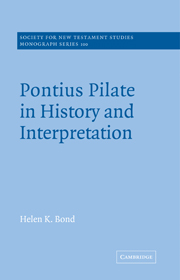Book contents
- Frontmatter
- Contents
- Preface
- Acknowledgements
- Abbreviations
- Map of the Roman province of Judaea, 6–41 ce
- 1 Pontius Pilate and the Roman province of Judaea
- 2 Pilate in Philo
- 3 Pilate in Josephus
- 4 Pilate in Mark's gospel
- 5 Pilate in Matthew's gospel
- 6 Pilate in Luke-Acts
- 7 Pilate in John's gospel
- 8 Historical events behind the gospel narratives
- 9 Conclusion
- Bibliography
- Index of texts cited
- Index of modern authors
- Index of main subjects
4 - Pilate in Mark's gospel
Published online by Cambridge University Press: 18 December 2009
- Frontmatter
- Contents
- Preface
- Acknowledgements
- Abbreviations
- Map of the Roman province of Judaea, 6–41 ce
- 1 Pontius Pilate and the Roman province of Judaea
- 2 Pilate in Philo
- 3 Pilate in Josephus
- 4 Pilate in Mark's gospel
- 5 Pilate in Matthew's gospel
- 6 Pilate in Luke-Acts
- 7 Pilate in John's gospel
- 8 Historical events behind the gospel narratives
- 9 Conclusion
- Bibliography
- Index of texts cited
- Index of modern authors
- Index of main subjects
Summary
With Mark's gospel we move from Jewish literature to our earliest surviving reference to Pilate in a Christian gospel. The work itself gives no specific date and there have been various attempts to fit the contents of the gospel to known historical events. At the earliest end of the spectrum a date shortly before Gaius' assassination has been suggested (41 ce) or, on the basis of possible Qumran fragments, just prior to 50 ce. The majority of scholars, however, date the gospel some time between 60 and 70 ce; more specifically, opinion is divided between whether it was written shortly before or shortly after the fall of Jerusalem. The place of composition is no less disputed with hypotheses ranging from Jerusalem, Alexandria, Antioch, Galilee to Rome, the last representing the majority view. Early church tradition is virtually unanimous in its assertion that the gospel was written in Rome shortly after Peter and Paul perished in the Neronian persecution of 64. Since the contents of the gospel seem to support the traditional view of its provenance, the following discussion assumes that Mark was writing for a predominantly gentile Christian audience in Rome after the persecution of 64 but before the fall of Jerusalem. It will be argued that the picture of Pilate which emerges from this gospel would be particularly appropriate for a community which had recently suffered such misery and humiliation at the hands of imperial command.
Pontius Pilate appears twice in Mark's gospel.
- Type
- Chapter
- Information
- Pontius Pilate in History and Interpretation , pp. 94 - 119Publisher: Cambridge University PressPrint publication year: 1998



